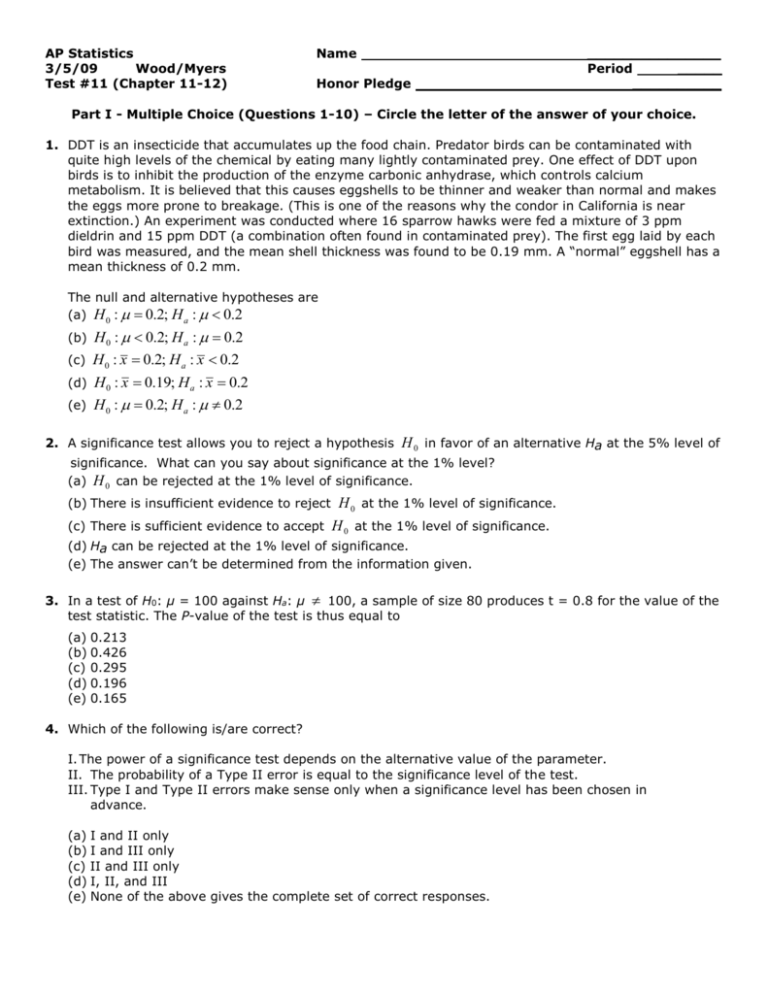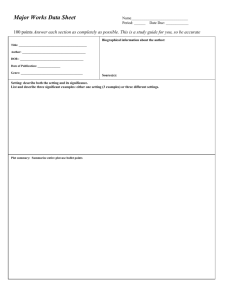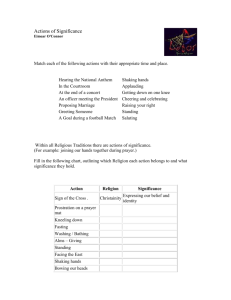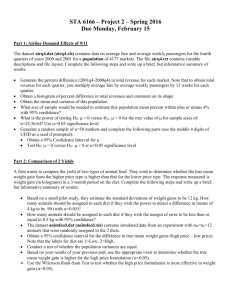AP Statistics - Test 11 - edventure-ga
advertisement

AP Statistics 3/5/09 Wood/Myers Test #11 (Chapter 11-12) Name Honor Pledge _______________ Period _____ __________ Part I - Multiple Choice (Questions 1-10) – Circle the letter of the answer of your choice. 1. DDT is an insecticide that accumulates up the food chain. Predator birds can be contaminated with quite high levels of the chemical by eating many lightly contaminated prey. One effect of DDT upon birds is to inhibit the production of the enzyme carbonic anhydrase, which controls calcium metabolism. It is believed that this causes eggshells to be thinner and weaker than normal and makes the eggs more prone to breakage. (This is one of the reasons why the condor in California is near extinction.) An experiment was conducted where 16 sparrow hawks were fed a mixture of 3 ppm dieldrin and 15 ppm DDT (a combination often found in contaminated prey). The first egg laid by each bird was measured, and the mean shell thickness was found to be 0.19 mm. A “normal” eggshell has a mean thickness of 0.2 mm. The null and alternative hypotheses are (a) H 0 : 0.2; H a : 0.2 (b) H 0 : 0.2; H a : 0.2 (c) H 0 : x 0.2; H a : x 0.2 (d) H 0 : x 0.19; H a : x 0.2 (e) H 0 : 0.2; H a : 0.2 2. A significance test allows you to reject a hypothesis H 0 in favor of an alternative Ha at the 5% level of significance. What can you say about significance at the 1% level? (a) H 0 can be rejected at the 1% level of significance. (b) There is insufficient evidence to reject H 0 at the 1% level of significance. (c) There is sufficient evidence to accept H 0 at the 1% level of significance. (d) Ha can be rejected at the 1% level of significance. (e) The answer can’t be determined from the information given. 3. In a test of H0: µ = 100 against Ha: µ 100, a sample of size 80 produces t = 0.8 for the value of the test statistic. The P-value of the test is thus equal to (a) 0.213 (b) 0.426 (c) 0.295 (d) 0.196 (e) 0.165 4. Which of the following is/are correct? I. The power of a significance test depends on the alternative value of the parameter. II. The probability of a Type II error is equal to the significance level of the test. III. Type I and Type II errors make sense only when a significance level has been chosen in advance. (a) I and II only (b) I and III only (c) II and III only (d) I, II, and III (e) None of the above gives the complete set of correct responses. 5. After once again losing a football game to the archrival, a college’s alumni association conducted a survey to see if alumni were in favor of firing the coach. An SRS of 100 alumni from the population of all living alumni was taken. 64 of the alumni in the sample were in favor of firing the coach. Suppose you wish to see if a majority of living alumni are in favor of firing the coach. The appropriate test statistic is (a) z (0.64 0.5) (0.64)(0.36) 100 (b) z (0.64 0.5) (0.5)(0.5) 100 (c) z (0.64 0.5) (0.64)(0.36) 64 (d) z (0.64 0.5) (0.5)(0.5) 64 (e) t (0.64 0.5) (0.5)(0.64) 100 6. A noted psychic was tested for ESP. The psychic was presented with 200 cards face down and asked to determine if the card was one of five symbols: a star, cross, circle, square, or three wavy lines. The psychic was correct in 50 cases. Let p represent the probability that the psychic correctly identifies the symbol on the card in a random trial. Assume the 200 trials can be treated as an SRS from the population of all guesses the psychic would make in his lifetime. Which inference procedure would you use to determine whether the psychic is doing better than just guessing? (a) one-proportion z test (b) one-sample t test (c) one-sample z test (d) one-proportion z interval (e) one-sample t interval 7. The water diet requires one to drink two cups of water every half hour from when one gets up until one goes to bed, but otherwise allows one to eat whatever one likes. Four adult volunteers agree to test the diet. They are weighed prior to beginning the diet and after six weeks on the diet. The weight (in pounds) are: Person Weight before the diet Weight after the diet 1 180 170 2 125 130 3 240 215 4 150 152 For the population of all adults, assume that the weight loss after six weeks on the diet (weight before beginning the diet – weight after six weeks on the diet) is Normally distributed with mean . To determine if the diet leads to weight loss, we test the hypotheses: Based on these data we conclude that (a) we would not reject H 0 at significance level 0.10. H0: µ = 0 vs. Ha: µ > 0 (b) we would reject H 0 at significance level 0.10 but not at level 0.05. (c) we would reject H 0 at significance level 0.05 but not at level 0.01. (d) we would reject H 0 at significance level 0.01. (e) none of these 8. Which of the following is not a correct statement about conditions for performing a significance test about an unknown population proportion p? (a) The data should come from a randomized experiment or simple random sample. (b) Individual measurements should be independent of one another. (c) The population distribution should be approximately Normal, unless the sample size is large. (d) Both np and n(1 – p) should be at least 10. (e) If you are sampling without replacement from a finite population, then you should sample no more than 10% of the population. 9. To determine the reliability of experts used in interpreting the results of polygraph examinations in criminal investigations, 280 cases were studied. The results were True Status Examiner’s Decision Innocent Guilty “Innocent 131 15 “Guilty” 9 125 If the hypotheses were H0: suspect is innocent vs. Ha: suspect is guilty, then we could estimate the probability of making a Type II error as (a) 15/280 (b) 9/280 (c) 15/140 (d) 9/140 (e) 15/146 10. A 95% confidence interval for µ is calculated to be (1.7, 3.5). It is now decided to test the hypothesis H0: µ = 0 versus Ha: µ 0 at the = 0.05 level, using the same data as used to construct the confidence interval. (a) We cannot test the hypothesis without the original data. (b) We cannot test the hypothesis at the = 0.05 level since the = 0.05 test is connected to the 97.5% confidence interval. (c) We can make the connection between hypothesis tests and confidence intervals only if the sample sizes are large. (d) We would reject H0 at level = 0.05. (e) We would accept H0 at level = 0.05. Part II – Free Response (Question 11-13) – Show your work and explain your results clearly. 11. Eleven percent of the products produced by an industrial process over the past several months fail to conform to the specifications. The company modifies the process in an attempt to reduce the rate of nonconformities. In a trial run, the modified process produces 16 nonconforming items out of a total of 300 produced. Do these results demonstrate that the modification is effective? 12. The nicotine content in cigarettes of a certain brand is Normally distributed with mean = 1.5 (in milligrams) and standard deviation 0.2 mg. The brand advertises that the mean nicotine content of their cigarettes is 1.5 mg, but you are suspicious and plan to investigate the advertised claim by testing the hypotheses H 0 : 1.5 versus H a : 1.5 at the 0.05 significance level. You will do so by measuring the nicotine content of 30 randomly selected cigarettes of this brand and computing the mean nicotine content x of your measurements. (a) Describe a Type I and a Type II error in this setting, and give the consequences of each. (b) Find the power of the test if 1.6 mg. (c) Describe two different types of changes you could make to increase the power of the test in the previous question.




